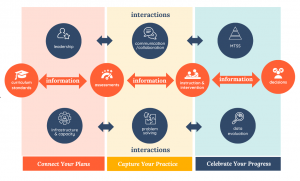Welcome to MTSS success! In this post we will first identify 4 critical sources of information that school leaders should prioritize. Second, we will dig deeper into the first critical source of information for school leaders: curriculum standards in the pacing guide. So, are you on pace?
Before we begin, let’s review the overall system. Remember, a system is a whole that consists of interdependent parts or components that interact to achieve a desired outcome. Multiple Tiered Systems of Support, or MTSS, has 6 interacting components. They are: leadership, infrastructure and capacity building, communication and collaboration, data based problem solving, data evaluation, and multiple tiers of support. These interacting components are connected together by information. The right information in the right interactions is critical to a culture of learning. This culture of learning is needed to design the system that leads to happiness and success for everyone.
Problem
Do you find yourself spending more time analyzing data than using it to improve instruction? Are you overwhelmed at the volume of data you have? What if you could focus on the data that makes the most sense, but are not sure where to begin? You’re not alone, but you already know that. The truth is, data overload is a real issue in education. Start by pinpointing which data is critical to your goals. Prioritize it so you won’t be bogged down in data beyond your control. Spend your time and energy influencing where it counts. So how do you, as a school leader, do this?
First, use technology to your advantage. Dot it automates the information school leaders should prioritize. Our technology frees up time for meaningful decisions and action.
Second, focus professional development on creating the right interactions. You can save time and energy by interacting with right teams using right information at the right time.
Priorities
When we think of data, we usually think test scores. In reality, data is everything we observe with our senses. This includes what is in the hallways, reports from screeners, lesson plans, and schedules. Even facial expressions are data points. What makes data useful is the meaning we ascribe it it. The purpose of the 6 components of MTSS interaction is to assign meaning to the data that matters most. School leaders find the most meaning in 4 sources which is the key to MTSS happiness and success.
Dot It is made to help you focus on these four critical sources of information defined by the MTSS research. They are: curriculum standards, assessments, instruction and intervention, and data driven decisions.
In this post, we will focus on curriculum standards in pacing guides as the first critical source of information for school leaders.
About Pacing Guides
Why Pacing Guides are Critical
Curriculum pacing guides are crucial in ensuring that teachers are able to cover all of the essential material within a given amount of time. Here are some reasons why the Dot it curriculum pacing guides are important:
- Quality: Pacing guides help ensure that all material is covered in clear time frames. This is particularly important for tested subject areas.
- Accountability: Pacing guides help hold teachers accountable for covering the material. It also allows administrators to monitor progress and ensure that teachers are meeting their goals.
- Consistency: Pacing guides promote consistency across classrooms. This ensures that all students are receiving the same quality education.
- Time management: Pacing guides help teachers manage their time effectively. They help teachers plan ahead for instruction, assessments, and other classroom activities.
- Flexibility: Pacing guides allow for flexibility in case of unforeseen events. These include circumstances such as school closures, weather-related issues, or other disruptions to the school schedule.
Overall, curriculum pacing guides are critical for ensuring that students receive a quality education. They provide structure so teachers are able to effectively plan, manage their time, and stay accountable for their progress.
Why We Undervalue Pacing Guides
Pacing guides can be expensive and tedious to make. Yet, after all that work, pacing guides are often undervalued as critical sources of information. Why is that?
First, you may lack training and understanding on how to use the curriculum pacing guides effectively. Second, there is often an overreliance on textbooks and other materials, leading to neglect of the pacing guide. Limited access to the pacing guides and resources are not always accessible for planning and preparation due to lack of technology.
Sometimes, teachers resist following the pacing guides because they represent new methods for teaching and learning. Leadership loses sight of the pacing guide and therefore, there is inadequate support. Pacing guides can be cumbersome when technology is not used effectively. Adapting the pacing guide to meet the needs of diverse learners is difficult. Finally, there are insufficient incentives or consequences for adhering to or failing to follow the pacing guide.
How to Make Pacing Guides Useable
A great curriculum pacing guide should have the following characteristics:
- Clear Learning Objectives: The guide should have clear and specific learning objectives that align with the curriculum standards.
- Realistic Timeline: The guide should provide a realistic timeline for instruction and assessment that allows for flexibility and adjustments.
- Balanced and Comprehensive: The guide should be well-balanced and comprehensive, covering all the necessary content and skills in the curriculum.
- Differentiated Instruction: The guide should include strategies for differentiated instruction to meet the needs of all learners in the classroom.
- Assessment: The guide should include opportunities for formative and summative assessment to monitor student progress and adjust instruction as needed.
- Collaboration: The guide should encourage collaboration and communication among teachers to ensure consistency and alignment across classrooms.
- Continuous Improvement: The guide should be reviewed and updated regularly to reflect changes in the curriculum or student needs, and to improve its effectiveness
Are You On Pace?
Why Schools Fall Behind
When it comes to following pacing guides, teachers often fall behind. Why does that happen? There are several reasons why teachers may fall behind when following pacing guides. Sometimes teachers need to spend more time on certain topics or skills if they find that their students are struggling or need more support. Unexpected events such as a school closure, a field trip, or a guest speaker can disrupt the pacing guide and cause teachers to fall behind.
Changes to the curriculum or instructional materials can require teachers to spend more time preparing for lessons or adapting their teaching strategies. Classroom management issues can also impact pacing, as teachers may need to spend more time addressing behavioral issues or managing student disruptions. Teachers may have a heavy workload with other responsibilities such as grading, lesson planning, and meetings, which can make it difficult to keep up with the pacing guide. Ultimately, it’s important for teachers to be flexible and adaptable when following pacing guides to ensure they are meeting the needs of their students while also staying on track with the curriculum.
Solutions for Staying on Pace
How can we help teachers stay on pace in the face of these challenges? One way is to build in extra time for unexpected events. You can plan for unexpected events such as school closures or guest speakers so teachers can adjust their pacing without falling too far behind. If teachers are absent, place students in classes where they can continue to receive critical instruction, especially if the teacher is out for more than a day. Professional development opportunities can help teachers better manage their workload, improve their classroom management skills, and learn new teaching strategies that can help them stay on pace.
Use data to inform instruction. Teachers can identify areas where students need more support and adjust their pacing guide to reflect these needs by regularly assessing student progress and adjusting instruction accordingly. Teachers can help other teachers share best practices, gain new insights, and develop more effective pacing guides that are better suited to their students’ needs.
Use technology to streamline tasks such as grading and lesson planning. Good technology frees up time for teachers to focus on instructional tasks and staying on pace with their pacing guide. We made Dot it for this very reason…to make teacher workload easier so they can focus on high quality instruction. The first critical source of information answers the question, “are you on pace?”






